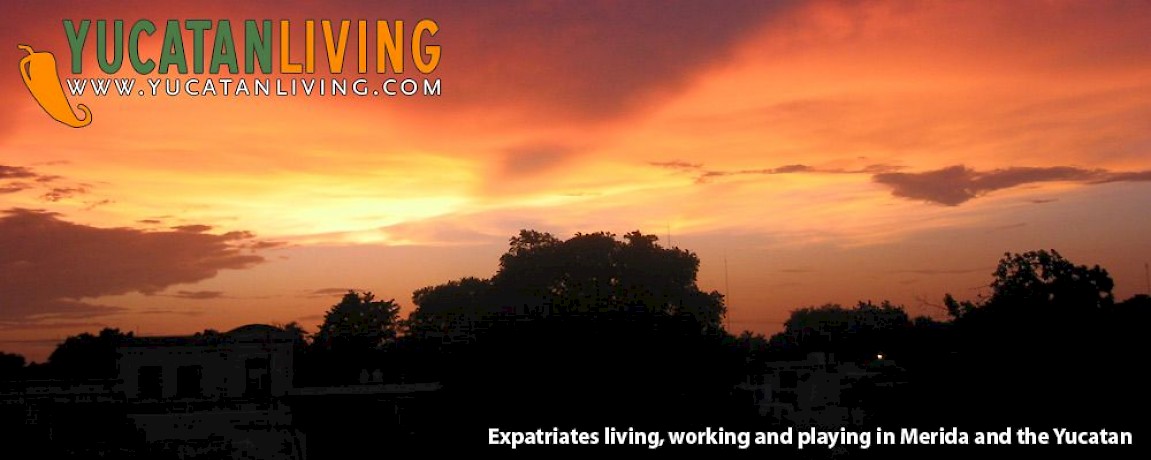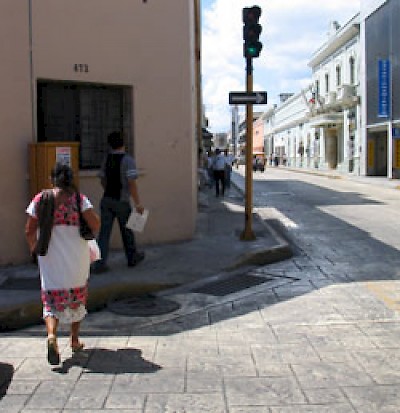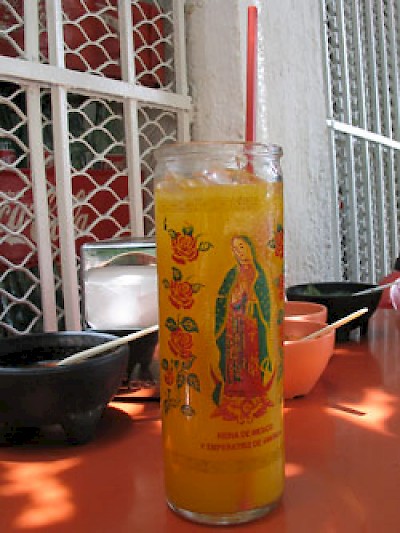Hay Calor!
For the past few days, the temperature here in Merida has soared and we are suddenly drinking a lot more water and Gatorade. It seems like only last week when it was a comfortable 80 degrees. Well, it really *was* only last week. The seasons turn quickly here, and this sudden change of weather tells us we're about to pay for our paradise with a little hay calor! (it’s hot!) Or if you prefer the Mayan: choco kin!
It doesn't confuse us anymore that in Mexico, as in most of the world, they report the temperature in Centigrade, which means it’s "only" 40 degrees right now. We now know that 40 degrees means a walk outside puts us in danger of heat exhaustion, but for the sake of our US audience we'll speak in Fahrenheit for the remainder of this article.
The Yucatan has four seasons, just like everyone else, but they are not very different. In fact, they are variations on only two themes: temperature and humidity.
Spring: hot and dry
Summer: hot and wet
Fall: cool and wet
Winter: cool and dry
Of course, the word “cool” is relative. We'll define cool to mean that the day's high temperature is below 90 degrees. We've seen a few days in January when the temperature dipped into the 50's at night and never rose above 70 during the day. There are several weeks during the winter months when you'll want a light coat or sweater. But in general, the cool days are still tropical, so shorts and a t-shirt in public and a sarong at home work for us.
Hot is also a relative term. The highest average temperature in Merida - usually recorded in May - is 97 degrees and it seldom goes higher than 105. Sounds hot enough, right? Well, there are places where we come from where the temperature can exceed a scorching 120 degrees. On paper, that makes Merida look a bit less punishing, but as anyone from the southwestern part of the United States will remind you: “…it’s dry heat.” Here in Yucatan, we have a different reminder: “it’s not the heat, it's the humidity.”
We're really tickled by the temperature report on weather.com when it says something like:
Merida
Temperature: 89
Feels Like: 104
What it should say is, “Feels Like: You're a Poached Egg”.
Humidity - Mother Nature’s warm, wet embrace – traps the heat in your body and raises your “core temperature”, which makes staying cool the first priority of living in the Yucatan.
Almost every aspect of Yucatan life - cultural, social and even architectural - is informed and influenced by the tropical climate. The traditional Mayan dress code is light, white cotton fabric, with panama style hats for men and a rebozo, or shawl, for the women. Surprisingly, you’ll seldom see locals wearing shorts or going shirtless; they prefer to keep their bodies covered. The main reason for this, we’ve observed, is to prevent a cool breeze, called a fresca, from sending a chill over clammy skin. This effect can cause muscle cramps and many believe it causes illness as well. When you are in a crowd in the Yucatan during the heat, you'll notice the distinct odor of baby powder. In this heat, baby powder is for everyone because it really does reduce the stickiness caused by such intense humid heat.
The Spanish tradition of siesta is popular in many parts of Mexico, and certainly here in Yucatan. The hottest part of the day is generally between the hours of 2:00 and 4:00 pm when it makes a lot of sense to stay indoors and rest, rather than court heat exhaustion. Most Yucatecos start their day rather early, often before sunrise, so they can eat breakfast and do their morning chores in the cool, early hours. The business day starts at 8:30 am and winds down by 2:00 pm. After lunch and a siesta, business picks back up and the formal day ends around sunset. The traditional dinner hour begins at 10:00 pm, and if you’re a real local, you may be chatting with friends or dancing salsa until 1:00 am or later. This lifestyle offers two days in one, with the majority of your social life spent during the coolest parts of the day. You don’t have to live here long to assimilate. In fact, it's harder not to.
One of the many charming features of Yucatan social life can be seen everywhere, from the smallest pueblos to the urban center of Merida, the largest city. After dark, entire families will tote any form of seating that may be handy outside their front doors so they can share the events of their day in cool, evening frescas. Passersby are obliged to walk through these impromptu living rooms, offering a polite “buenas noches” to the adults, an admiring smile for the children and a pat for the dog.
Tall and often ornate Spanish colonial facades line the streets of the historical centers of Yucatan's cities such as Merida, Izamal and Valladolid. This creates a somewhat canyon-like feel when walking between them, but can also offer an opportunity to beat the heat. With the exception of high noon, one side of the street is in shade and the other in sunlight. We call these the Yucateco side and the Gringo side, respectively. Locals instinctively choose the cooler but more crowded shady side, while tourists choose the less populated sun-drenched side and arrive at their destination sunburned and dehydrated.
One of the first Spanish words we learned after moving here was “tranquilo”, which has many uses, but generally means “relax, take it easy”. There’s a lot of wisdom in this word (in many different contexts) but the most noticeable one is that Yucatecos move slowly. There is no "hustle" in Yucatan. If you stride rapidly down the street as if you are in New York, your “core temperature” rises and you blithely melt into the pavement.
The architecture of Yucatan’s colonial homes is well adapted to the climate. Behind those tall facades are equally tall ceilings, often 18 to 25 feet above the tiled floors. As the heat of the day rises, it collects near the ceiling, while the tiles maintain a cooler atmosphere below. Add ceiling fans for circulation, thick limestone walls and a central patio for drawing fresh air into the surrounding rooms. The result is an ambiance somewhat like a wine cellar.
Despite their resemblance to mansions found in Europe and other colonial parts of Latin America, there is one thing you’ll never see in a colonial home in Merida: a fireplace.
But you will find something you’ll seldom see elsewhere: the hammock. This bit of Yucatan “furniture” is more popular here than sleeping on a mattress or sitting in an upholstered chair. Besides taking up less space (they can be easily stowed during the day), hammocks ventilate the entire body. On warm, sultry nights, sleeping in a hammock under a ceiling fan is a more pleasant experience than tossing and turning on a humid mattress. And nothing beats a hammock for a mid-day siesta.
Of course, the same modern technology that made such exotic destinations as Las Vegas and Miami safe for habitation is widely used here, namely air conditioning. These systems are usually “split” units, with the condenser located on the roof and the ventilator hung high on an interior wall. Most colonial homes are too large to fully air condition in this way, so you usually find them only in bedrooms. During summer, the operating costs of keeping cool at home can exceed $200 per month in electric bills.
Since many of the locals can’t afford to air condition their homes, they seek it out in other venues. On a particularly hot day, you’ll find that the large grocery chains, the shopping malls and especially the cineplex are packed with crowds who are there for the same reason others go to the beach.
Another option is to visit a local cenote, which is an opening in the limestone that exposes the aquifer underneath. The Yucatan Peninsula is dotted with hundreds of them. Some are on the surface, some in grottos and others hidden in caves. The water is cool, clear and usually around 72 degrees, which makes for a very refreshing swim.
There is a tradition in Merida that probably dates back to the ancient Maya. Every July and August, everyone takes off for the coast. Most go north to the Gulf of Mexico where a reliable trade wind blows from offshore, the same one that brought the Spanish conquerors from Europe. People rent the beach houses that North American “snowbirds” use during winter. Family and friends are invited. Spontaneous nighttime fiestas are celebrated on the streets and malecon, with seafood, music and plenty of cold cerveza.
A tropical environment like the Yucatan is for people who enjoy activities for cooling off. If you prefer to cuddle by the fireplace with the hush of snowfall outside your window… well, you might want to look elsewhere. On the other hand, if you like a dip in the pool and a cold drink while perfecting your tan, then you’re in the right place.
One last important linguistic note: there are (at least) three words in Spanish for “hot”. They are picante, caliente and calor. Gringos tend to confuse these. Picante, which comes from the verb picar (to sting) refers to anything spicy. Chiles and salsa are picante. Caliente generally involves fire. When you heat water it is caliente. Caliente also has the same sexual connotations as “hot” in English. A hotdog, literally translated, means a dog that is in heat. Calor refers to the weather.
These distinctions get blurred a bit. If it’s hot outside (calor) and it makes you feel hot, then when referring to yourself, use caliente, because you have been heated. The real trouble occurs with the difference between the English and Spanish use of “be” and “have”. If you say “estoy caliente” (I am hot), then you are confessing to being sexually aroused. You must instead say “tengo caliente” (I have hot). Although body language often helps clear up any misunderstandings, in neither case does it help to pant with your tongue hanging out.
Although it's unlikely you'd ever need to here, never use the expression, “estoy frio” (literally, I am cold). This means you are dead.











Comments
manuelito 19 years ago
"se esta poniendo caluroso" it means something like it's gettin' warm,and "se esta poniendo caliente" it means it's gettin' hot,and all these sentences they refer to the weather,only a remark in the first sentence it has an "U"instead an "O",well all i have to say is that,i think u guys should talk about the FIESTA DEL PUEBLO,it means something like TOWN FAIR,it is really hard for me to find an exactly word for the translation cos i only have like 4 years speaking,writting and reading english and it is really hard for me but ask around it is a fair in every single town in yucatan,with fireworks,and FOOD!!!!!!!!,beer,and a lots of fun with "corridas de toros",i hope u guys have the time to go out and be there and talk about it later that'll be awesome,well that,s all i have to say for now. stay cool and have fun.
Reply
Tesha 19 years ago
Hola gringos! I'm a gringa originally from St. Louis, Missouri. I moved here in December 2005. I haven't been here very long, but I have learned so much in the time I've been here. When I first arrived everyone asked what I thought of the weather here, and it being December, I thought it was great compared to the freezing weather I came from. Everyone laughed and said "Wait for April...then tell me how you like it". Now I understand their laughter. Hay mucho calor!!! I'm slowly getting used to the heat and appreciating the hamaca. I just want to remind all the gringos here....remember how fortunate you are to know the snow, all the locals I've met have never seen it, and make it a life goal to experience it. Muchos saludos!!!
Reply
Working Gringos 19 years ago
The original WordPress template is called Connections and was designed by Patricia Muller. You can get it here:
http://downloads.wordpress.org/theme/connections.zip
Many modifications and additions by Mr. W. Gringo... He's so clever that way.
Hace calor is pretty commonly used, but hay calor seems more emphatic and maybe it's more like the Mayan. We love "esta poniendo caloroso"! We'll try it and see if it flies here in the Yucatan. They seem to have their own idiosyncracies here. Since we have learned our Spanish here, apparently we speak with a "Yucatecan" accent... kind of like speaking English with a Southern drawl, apparently.
Reply
kathy 19 years ago
("hace calor" is what I've always heard or "esta poniendo caloroso" course, your verb of choice could be just about anything or "esta haciendo un calor infernal") I never took Spanish classes, but that is what my ear says. :)
We spent last April and May seaside in Quintana Roo and know well the weather. We're stuck in Mazatlan for the next month (instead of Oaxaca City where I wanted to be) but yesterday is was a lovely 80's with humidity bringing it up just under 100). I'm so out of touch with Celcius.
I'm really enjoying your blog when the kids give me a chance to read. I'm even more loving your template. Did you design it yourselves? If not, do you know what it is called and where I can download it? TIA!
Reply
« Back (30 to 34 comments)